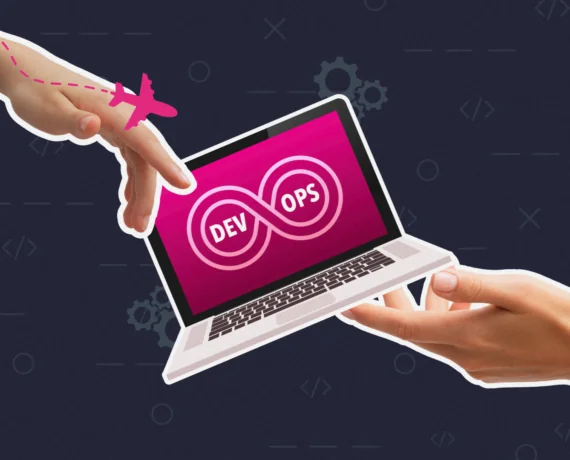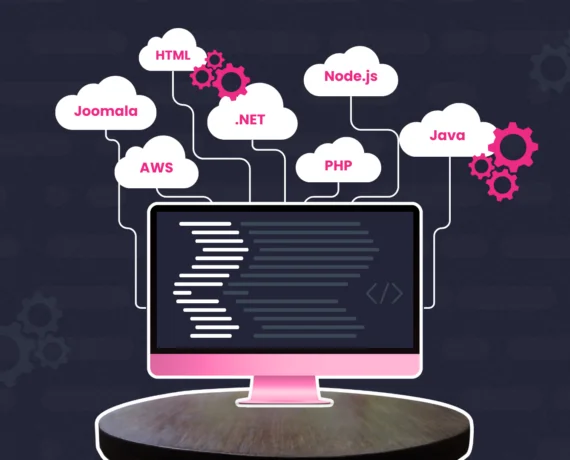Table of Content
- Why Is It Essential to Move to Cloud?
- What Is a Cloud Service Provider and How to Choose One
- Cloud Infrastructure and Architecture
- Step-by-Step Migration Strategy From On-Premise to Cloud
- Cloud Migration Challenges to Overcome
- Cloud Migration Best Practices
- Disaster Recovery and Business Continuity
- Real-world Examples of Successful On-premise to Cloud Migrations
Let's develop your migration strategy from on premise to cloud together
Book a callThe cloud migration process is no longer an option; it’s an essentiality for businesses that want to stay abreast with technological advancements, get better performance, and improve customer experience. Cloud solutions have rapidly become more popular, but this quick cloud transformation was too unexpected for organizations, and many of them were just questioned— what to do next? To eliminate such situations, let’s discover more about services and operations to be moved to the cloud, the most reliable cloud service providers, cloud migration strategies, and the main challenges awaiting businesses during the cloud transformation process.
Discover about software development delays and why projects end up late
Why Is It Essential to Move From On-Premise to Cloud?
It’s not a secret anymore that many businesses from different niches had already transitioned from an on-premise system to cloud computing—but why? When migrating to the cloud, an organization gets many benefits both from a business and technical perspective, among which are:
-
Broaden market reach
With cloud-native development, you will reach larger audiences without rebuilding the application, processing millions of requests per second.
-
Faster market entry
Combining DevOps with Agile, businesses accelerate both technology delivery and time-to-market. Correctly implementing best DevOps practices generates the speed-up of the software development process.
Check this blog article to discover more about the software development requirements.
-
Cost optimization
Cloud-native app development provides you with pricing flexibility by paying only for the computational resources.
-
Responsive technology usage
Cloud migration improves flexibility, allowing developers to suitably combine operating systems, web platforms, programming languages, and databases as needed.
-
No vendor lock-in
There’ll be no need to stick to a certain cloud provider if it doesn’t suit your business. You can work in any cloud and transfer between different ones.
-
Accessible infrastructure administration
Cloud-native apps are easy to maintain since they have microservices that can be updated due to the extension of the application functionalities.
-
Failures resilience
Since cloud apps can automatically process failures, they are resilient to any breakdowns by nature. You can effortlessly provide some updates without disrupting the end-users.
Looking for a tech partner for your Project?
What Is a Cloud Service Provider and How to Choose One
You might need a place to store all your data, run applications, have databases, or even need computing power to handle different tasks, but buying and managing your own servers and data centers can not only be very overwhelming but also very expensive. A service cloud provider lets you use their powerful computers, big storage spaces, and software over the internet.
Even if there’re more than 100 cloud service providers, we all know the leading ones: AWS, Azure, and Google Cloud. However, notwithstanding that Google Cloud and Azure appeared on the market a few years later after Amazon Web Services, they have quickly adapted and created decent competition for AWS, becoming reliable cloud providers both for small and large businesses. Selecting the appropriate cloud service provider is crucial, as it involves evaluating factors such as pricing, scalability, security features, and compliance requirements to ensure it aligns with your organization’s specific needs.
Here’s what you should know about each one to help you make a more informed decision:
-
Azure cloud services
Azure is a Microsoft solution that seamlessly integrates with Windows, VBS, SQL, databases, and Active Directory. It offers a big range of services, such as computing, networks, security, and many more. You only pay for the used resources on a minute payment basis, making it more cost-effective for those who have already invested in the Windows ecosystem. Azure also supports hybrid solutions.
-
Amazon Web Services (AWS)
AWS is one of the largest cloud providers, known for its secure environment for cloud computing. They offer a range of instruments, from internetwork monitors and endpoint protection to vulnerability scanners. AWS excels in scalability and supports hybrid solutions.
-
Google Cloud Computing Services (GCP)
GCP is best known for its security and low prices. GCP ensures protection from the physical infrastructure to operational processes. Pricing is based on pay-per-minute billing. The hybrid cloud support was introduced in 2018, strengthening the focus on multi- and hybrid cloud workloads using Anthos.
To get rid of any hesitation you may have regarding the choice among three of these, let’s have a closer look at the detailed table.
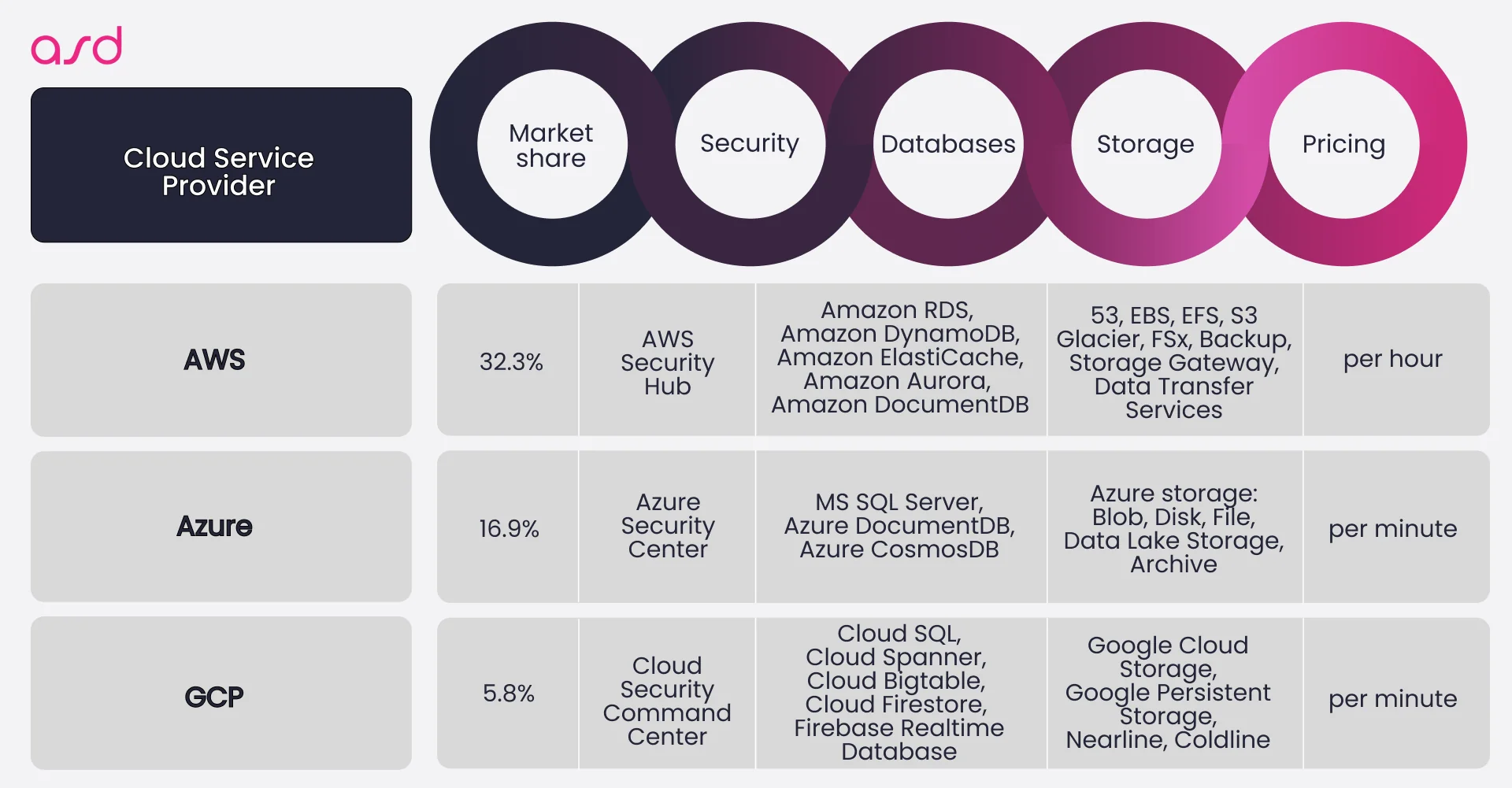
It’s not hard to notice that there’s no total winner. All three create a secure and effective environment with their special capabilities. Again, all the technology-related decisions depend on the exact business needs and state of the market.
Cloud Infrastructure and Architecture
Cloud infrastructure and architecture form the backbone of any successful cloud migration. These virtual computing resources and services, provided over the Internet by a cloud service provider, include storage, networking, and computing power. The flexibility and scalability of cloud infrastructure allow organizations to adjust their storage and computing needs in real-time, based on demand. A well-designed cloud infrastructure is crucial for leveraging the full benefits of cloud computing, such as cost efficiency, scalability, and flexibility.
Designing a Cloud Infrastructure
Designing a cloud infrastructure involves several critical considerations. First, you need to decide on the type of cloud deployment that best suits your organization—whether it’s public, private, or hybrid. Each model has its own set of advantages and challenges, so it’s essential to choose the one that aligns with your business goals and regulatory requirements.
Next, selecting the right cloud service provider is paramount. The provider should offer services that meet your current and future needs while ensuring data security, compliance, and cost efficiency. A scalable and flexible cloud architecture is also vital. This means designing your cloud environment to handle varying workloads and to grow with your business. Implementing robust security measures, such as access controls and data encryption, is essential to protect your data and ensure compliance with industry standards.
By carefully planning and designing your cloud infrastructure, you can ensure a smooth and successful transition to the cloud. This strategic approach allows you to fully capitalize on the benefits of cloud computing, from cost savings to enhanced operational agility.
Step-by-Step Migration Strategy From On-Premise to Cloud
A successful cloud journey consists of three stages: discovering, planning, and executing. Understanding the current data environment is crucial before initiating a data migration project, as it helps identify potential challenges and tailor the migration strategy to meet evolving needs. In this section, we’ll go through each stage, showing you how and what needs to be done in each of the three stages.
Define Current State
The cloud migration journey begins with identifying current inventory assets and deciding which one to migrate to the cloud, which not to, and which ones need fixing.
- Identify all your hardware, software, and data currently in use, including your on premise infrastructure. Determine which applications and data you want to migrate to the cloud.
- Set and clarify your objectives, such as the purpose of the migration.
Plan
Once you have all the theoretical parts in place, we can move on to developing a more practical plan that you will follow along this process of migrating from on-premise to cloud.
- Choose a Cloud Service Provider (CSP) that fits your needs and goals (use the last section as guidance).
- Set and clarify your objectives, such as the purpose of the migration.
- Develop a detailed cloud migration plan, including choosing a cloud deployment model (private, public, and hybrid), tracking progress, and managing financial impact.
- Set clear expectations of your estimated budget and timeline for the entire migration process.
Develop a Migration Strategy
This step is all about deciding on which migration approach to follow. This can vary from Lift and Shift, Refactor, Replatform, Repurchase, Retire, and Retain.
- Take some time to research each specific migration approach to gather as much info about each one.
- Determine which approach is best for migrating your specific applications and data.
- Develop a strategic migration plan that includes a detailed migration roadmap. This plan should be informed by a thorough assessment of existing infrastructure and resources, allowing for the identification of challenges and guiding the effective sequencing of migration activities. Include timelines, resources, and requirements for each step of the process.
Conduct a Data Modeling and Architecture
Design your data architecture in the cloud and perform data modelling to make sure all your data is organized, secure, and easily accessible in the cloud. Implementing a robust data governance strategy is crucial to ensure data integrity, privacy, and overall control during these processes.
- Decide and create data warehouses, data lakes, or even both depending on what suits your needs best.
- Create a well-structured plan for keeping your data safe from vanishing or losing it by backing up and restoring it.
Optimize Applications and Infrastructure
To further reduce costs, improve performance, and increase any action’s efficiency, optimize your applications and infrastructure.
- Check which applications need updating to take advantage of auto-scaling and managed services.
- Ensure all your data is complete and formatted correctly so they will work better in the cloud.
- Choose and use certain automation tools and cloud migration tools to help you with smaller tasks, such as scaling and monitoring, to save more time and avoid the risk of potential errors.
Let’s talk about your project? Feel free to ask any additional questions you might have. Our experts will be glad to assist you.

Secure and Protect the Data
Integrate security measures to ensure compliance with industry standards and protect your data.
- Use encryption tools to encrypt all your data, especially critical data, and keep any unwanted users away.
- Regularly check and solve any potential vulnerabilities.
- Read all the industry regulations, such as GDPR or HIPPA, to ensure your cloud is fully compliant.
Move, Test, and Optimize
This is the final step, which includes moving all your verified data to the cloud, testing it, and optimizing if necessary.
- Start with smaller systems and gradually advance to the bigger ones to better spot and fix any issues in the new cloud environment.
- Don’t rush the moving process, test and double-check everything to make sure it works as expected.
- Once everything is moved to the cloud, continuously check if things are running smoothly, find ways to improve, reduce costs, and keep everything secure.
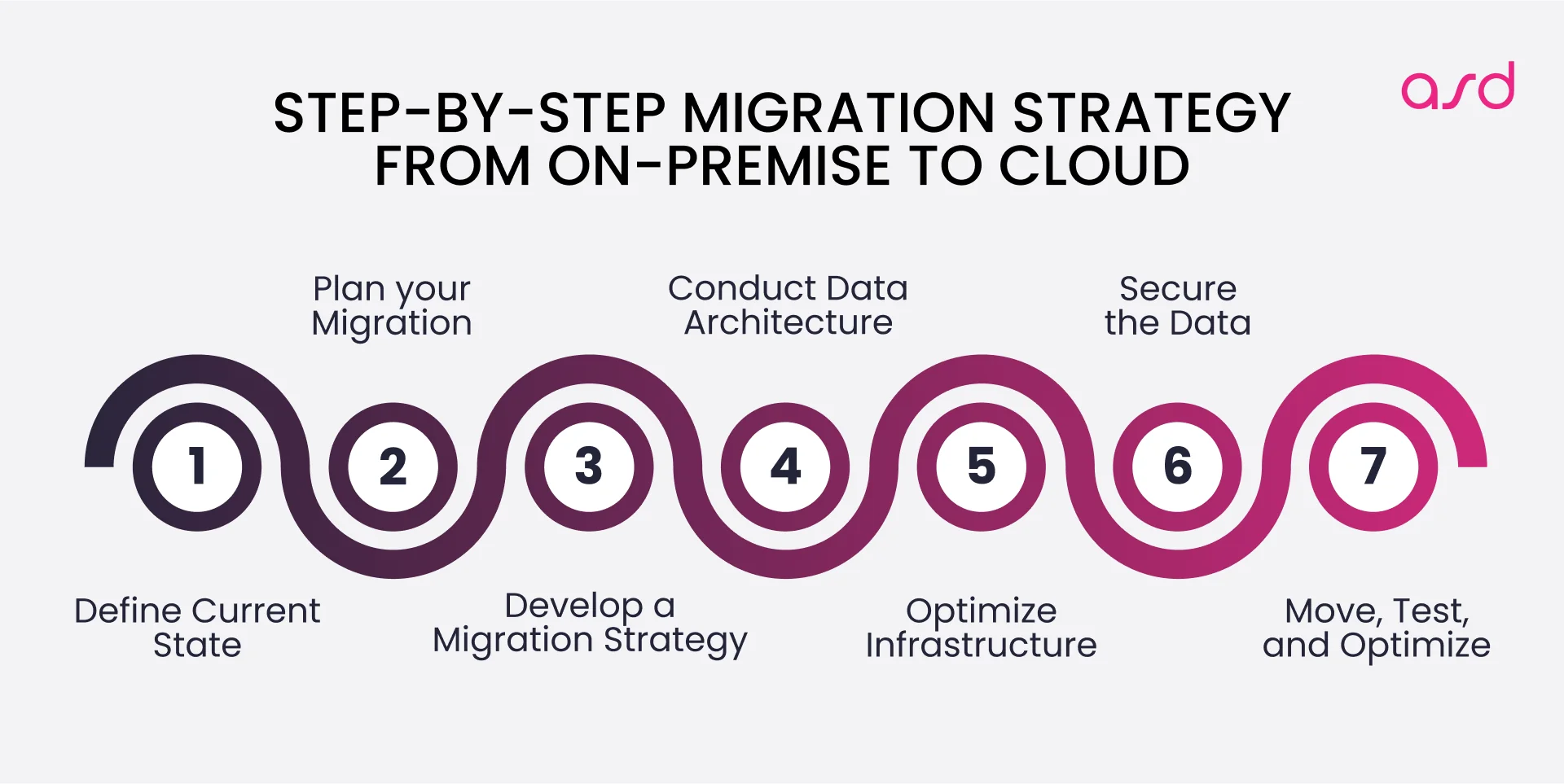
Ensuring Seamless Integration
Achieving seamless integration between different cloud services and systems is a critical aspect of cloud migration. This requires meticulous planning and execution. Start by selecting cloud services and systems that are inherently compatible with each other. Designing a scalable and flexible cloud architecture is also crucial, as it allows for easy integration and expansion.
Utilizing appropriate integration tools and technologies, such as APIs and data migration tools, can significantly streamline the process. These tools facilitate the smooth transfer and synchronization of data between different systems, ensuring data integrity and quality. Additionally, implementing robust security measures, such as encryption and access controls, helps protect your data during the integration process.
By ensuring seamless integration, organizations can maximize the benefits of cloud computing while minimizing the risks and challenges associated with cloud migration. This includes maintaining data integrity, ensuring data quality, and safeguarding data security, all of which are essential for a successful cloud migration.
Cloud Migration Challenges to Overcome
Nobody said that this process of migrating from on-premise to the cloud is an easy and risk-free action. Migration projects come with a lot of challenges and potential risks, such as wasted costs, complex infrastructure, data loss, downtime, and many other things that can make it difficult to migrate to the cloud.
If you want to establish a secure transfer of the apps and data, follow the recommendations listed below:
-
Optimize the cloud costs to prevent wasted costs
To prevent overspending and ensure you keep track of all your payments, use a cost management strategy to better control and monitor your cloud expenses.
-
Assess your IT infrastructure to make it “fit” for the cloud
Check all of your applications, data, and hardware to ensure they are compatible with the cloud to ensure better performance and scalability.
-
Resolve security issues to prevent threads
Prevent any potential security breaches by implementing security measures such as encrypting your data, setting up proper access controls, and regularly conducting security audits.
-
Fix downtime issues
Plan and test migration phases to reduce disruptions and ensure a smooth transition. Cloud migration strategy seems to be a hard process, though, with the proper preparations, you will definitely succeed and get rewarded. Adopting cloud solutions will empower you with scalability, cost-effectiveness, and market-driven innovations. Do not hesitate to take a risk today so that you won’t regret it tomorrow.
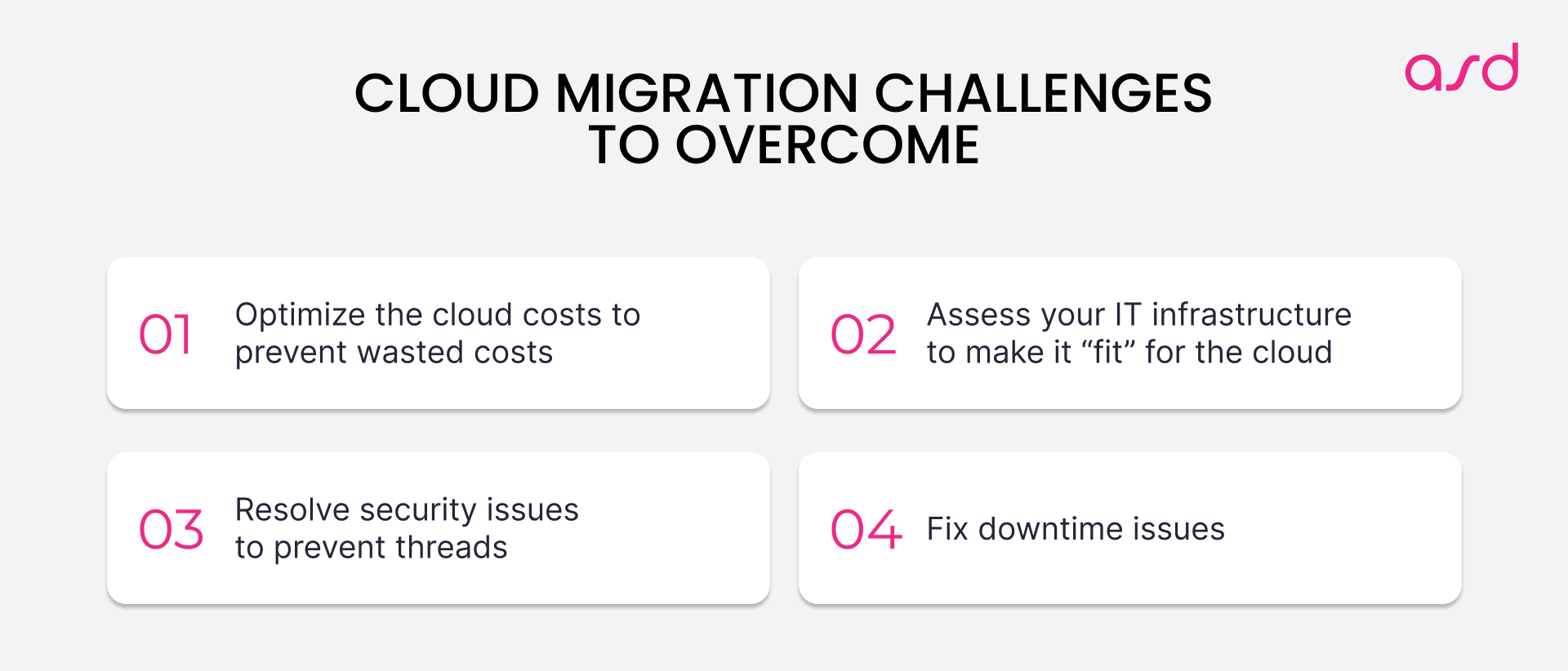
Cloud Migration Best Practices
Besides the step-by-step framework we talked about earlier, there are a few things that many people disconsider and skip, eventually having a bad experience during or after the migration process. One critical step is creating a detailed data migration plan. A well-structured plan should outline phases of the project, assign roles, set timelines, and identify potential risks, ensuring that the migration is both efficient and secure. To ensure you will have a smooth and successful cloud migration, follow these 6 best practices you have to know and apply:
Planning and Strategy Development
- Analyze your IT infrastructure: Start by analyzing all of your current hardware, software, network configurations, and data storage, including any on-premises systems. This will help you understand the starting point of your migration process.
- Categorize your data: Thoughtfully categorize your data based on importance and complexity and decide on the order of migration.
- Choose a suitable cloud service: Use the best cloud service based on your needs.
Cleansing and Transformation Data
- Remove redundant data: Before migrating, eliminate any data that is unnecessary, outdated, or duplicated.
- Standardize data formats for compatibility: Check if your data is in the same format and structure as the cloud platform; otherwise, perform necessary data transformations. Effective data management strategies, including master data management, are essential to ensure data integrity, quality, and security during this process.
Ensuring Data Security and Compliance
- Implement security measures: Use encryption and access controls to protect data both in transit and at rest. During the data migration process, ensure that all data transfers are secure and efficient, leveraging FTP server capabilities for reliable data movement.
- Ensure cloud service compliance: Check if your chosen cloud provider complies with relevant data protection and privacy regulations (GDPR, HIPAA, etc.).
Evaluate Network and Bandwidth
- Assess network capacity: Determine if your network’s capacity (bandwidth, latency, and reliability) will support cloud workloads and effectively manage cloud resources.
- Implement redundancy and failover mechanisms: To ensure constant availability during and after migration, and to minimize downtime, use multiple internet service providers or load balancers.
Set-up Backup and Recovery
- Data backup: Create backups of your data before migration to prevent any data loss in case of critical failures. Consider whether your backups will be stored in a traditional data center or in the cloud, as this will affect your recovery options.
- Develop a recovery plan: Think of a recovery plan that will help you in the worst-case scenario.
Testing and Validation
- Conduct testing of migrated applications and data: Before full deployment, perform rigorous testing to identify and fix immediate issues.
- Validate data integrity: Use validation tools to verify and validate your data integrity.
- Post migration optimization: Engage in ongoing monitoring of performance and costs to avoid bottlenecks and ensure efficiency. Test configurations and secure systems to maintain compliance and maximize resource utilization in the cloud environment.
These practices will help you minimize risks and overcome any challenges that may appear during the process. Keep in mind that this is not only available during the migration process, this is an ongoing effort that goes way further than the actual migration to the cloud. Constantly manage and optimize your data to ensure everything runs smoothly, remains secure, and is cost-effective.
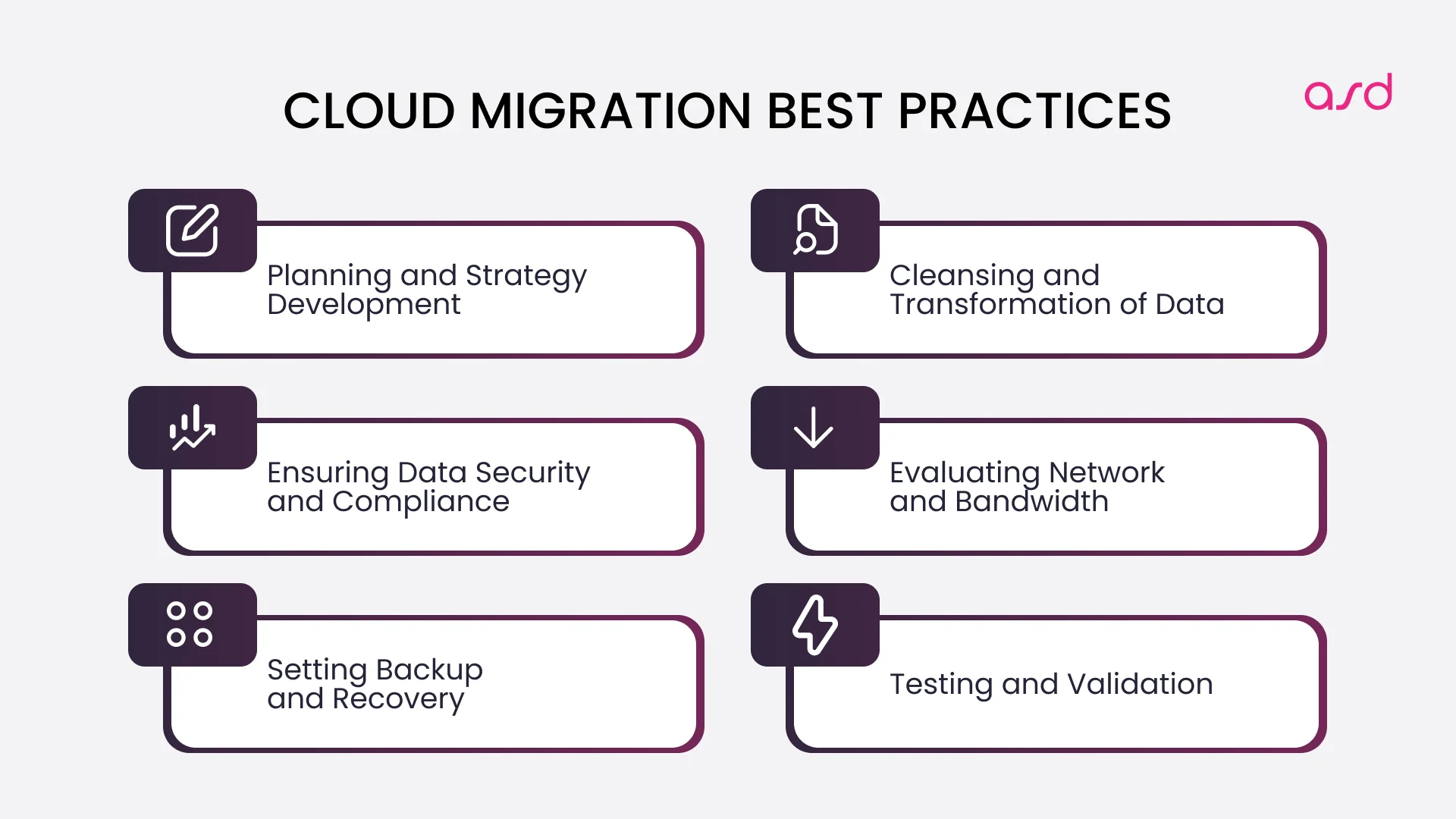
Disaster Recovery and Business Continuity
Disaster recovery and business continuity are critical components of a successful cloud migration strategy. These concepts refer to an organization’s ability to quickly recover from a disaster or disruption and ensure that business operations continue uninterrupted. Effective disaster recovery and business continuity planning enable businesses to minimize the risks and challenges associated with cloud migration, ensuring that cloud-based applications and data remain available and accessible.
Ensuring Business Continuity
Ensuring business continuity in the cloud requires careful planning and execution. Start by selecting a cloud service provider that offers robust disaster recovery and business continuity capabilities. This includes features such as automated backups, data replication, and failover mechanisms. Designing a scalable and flexible cloud architecture is also essential, as it allows your organization to quickly adapt to changing circumstances and recover from disruptions.
Implementing appropriate disaster recovery and business continuity tools and technologies is crucial. These may include backup and restore solutions, failover systems, and data replication services. By ensuring that your cloud-based applications and data are always available and accessible, you can minimize downtime and ensure business continuity.
Additionally, protecting sensitive data and meeting data security and compliance requirements are paramount. This involves implementing robust security measures, such as encryption and access controls, and regularly conducting security audits. Organizations should also consider adopting a multi-cloud strategy, using multiple cloud providers to ensure redundancy and availability. This approach helps mitigate the risk of a single point of failure and ensures that your applications and data remain accessible, even in the event of a disaster or disruption.
By carefully planning and implementing these strategies, organizations can ensure business continuity in the cloud, minimizing the risks and challenges associated with cloud migration and ensuring a successful transition.
Real-world Examples of Successful On-premise to Cloud Migrations
A recent study states that 30-40% of companies notice a reduction in IT costs after migrating to the cloud, 50% of companies saw a 20-30% improvement in operational efficiency, and 60% of businesses experienced significant improvements in scalability and flexibility. This is all thanks to the elimination of capital expenses, better resource management, and the ability to easily scale resources up and down based on demand. Additionally, many companies report significant savings, both immediate and long-term, as they transition to cloud services. Here are some names you surely heard of that took the leap and moved to the cloud:
-
INSTAGRAM
Considering the rapidly growing user base that Instagram had to handle, the smartest move they could make was migrating to the cloud. It didn’t only help them become more flexible and scale further, but also efficiently add new updates and features.
-
AIRBNB
Airbnb has a large number of algorithms, pricing models, and features to improve customer experience, so migrating to the cloud allowed them to better process and analyze huge amounts of data.
-
SPOTIFY
Spotify decided to migrate to the cloud in 2016, which helped the company enhance its data analytics capabilities, faster development cycles, and overall better user experience. The cloud can easily handle and support Spotify’s large music library and ensure a smooth listening experience by managing an enormous amount of streaming data.
On-premise to Cloud Migration: Final Words
The single most important thing in the entire on-premise to cloud migration strategy is to take each thing one at a time to ensure you’re not skipping or making any mistakes that could be hardly fixed later. In essence, if you carefully develop a roadmap and have the ability to overcome any challenges that may appear along the way, everything should go smoothly. Cloud adoption is crucial as it leads to improved application performance, organizational agility, and the ability to innovate rapidly, facilitated by the infrastructure provided by Cloud Service Providers. If you are stuck at the software development part and need an expert’s help, check out our software development outsourcing services.
Questions? Answers!
How do I create a comprehensive migration plan?
Start by having a clear understanding of your objectives in terms of cost savings and scalability, as well as setting clear success metrics. Now, move on to assessing your entire IT inventory (software, data, and applications) and figuring which are ready for the cloud and which need improvement.
Choose the right cloud model and provider that best fits your needs, and develop a roadmap containing a timeline and steps for each phase. Try to begin with less intricate systems to test and improve if necessary.
Now, start allocating resources and creating a good and stable backup plan, followed by migrating your data, testing, and continuously improving the performance.
What are the key benefits of cloud migration?
There are 3 key benefits of migrating from on-premise to cloud. The first one is the reduced costs, since this is based on a pay-as-you-go model, so you don’t have to pay for expensive on-premises hardware and infrastructure. The second benefit is the opportunity for flexible scaling of resources since you can easily modify the amount of computing power you need. The last benefit is the accessibility of your files and applications from anywhere in the world where you have an internet connection.
How can I ensure data security and compliance during the migration process?
Ensuring data security and compliance during the migration process starts by choosing a reliable cloud provider with strong and efficient security features. Also, always encrypt your data during the migration process and after to make sure unwanted issues or people access your files. You should also constantly perform security tests to keep track of any vulnerabilities or system breaches. To maintain your cloud compliance and protection, train your team on all cloud regulations, such as GDPR or HIPPA.


